|
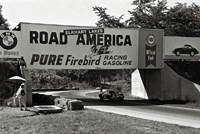 |
The crossover at Turn 13 was the first bridge built when Road America,
opened in September 1955. Transporters, cars and
pedestrians used it. Bill Mitchell Bridge was the only crossing point
to the infield on the north side that allowed access to the
main paddock when the track was hot with cars.
It was constructed of concrete with steel girders and beams
supporting the roadway.
The bridge was enclosed and clad with corrugated
aluminum panels to protect speeding cars and drivers who
crossed under it from traffic and spectator interference. It was also the
primary route for competitors and race officials
entering the
main competition paddock. |
|
William L. "Bill"
Mitchell (1912-1988) was Vice President of Design at GM
between 1958-1977. He was an avid racer who fielded the
original Sting Ray racer driven by Corvette legends John
Fitch and Dick Thompson at Road America. Mitchell chose
Elkhart Lake as the venue to preview his stunning Mako
Shark concept car in June 1961; the Shark’s sharp-edged
body and hidden headlights foreshadowed key features of
the production 1963 Corvette.
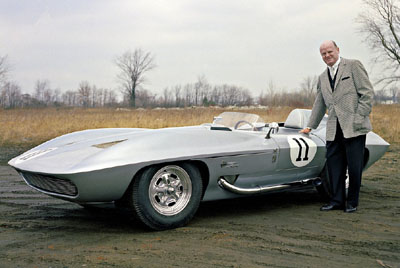
Wisconsin-based racers Augie Pabst and Jim Jeffords
excelled in sports car racing in the early ’60s with
their Chevy-powered machines. The lightweight Grand
Sport Corvette created by Corvette chief engineer Zora
Arkus-Duntov rumbled through Road America’s rolling
hills with racing luminaries Roger Penske, Jim Hall and
Hap Sharp sharing the driving chores. Notable Chevrolet
racers who have made their mark on the legendary circuit
include Tony DeLorenzo, Jerry Thompson, John Greenwood,
John Heinricy, Ron Fellows, and many more. In modern
times, Corvette Racing has notched six victories at Road
America in ALMS competition.
Mitchell was responsible for the design of over
72.5 million cars produced by GM, including the 1963
Chevrolet Corvette Stingray, the 1963 Buick Riviera, and
the 1970 Chevrolet Camaro.
Road America named the turn 13 crossover bridge in honor
of Bill Mitchell, who was a staunch supporter of the track.
Contrary to belief by some, including Wikipedia, the
bridge was not named for American general Billy
Mitchell.
|
|
West Elevation of Mitchell Bridge
Series of views looking east from Fireman's Hill |
|
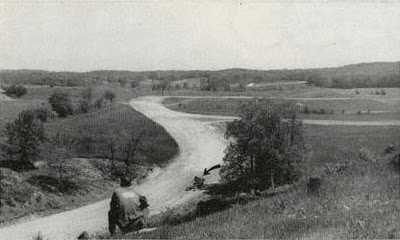
|
Before the bridge was built at T 13.
The road course has been graded but not paved yet. Photo
(looking east) from Fireman's Hill in June 1955. The arrow points to
bridge's location, which would span behind tree. The
bridge was in place by the first race on September
10-11, 1955. |
|
|
(ABOVE) The track has been graded and course base layer put
down. Turn 13 bend is in the foreground; the black arrow is
where
boring sample was taken before constructing the
vehicle crossover
bridge. The shortened course link is off to the right (middle).
Turn 14 is beyond and is the last corner before the main
straight and
start-finish line. |
|
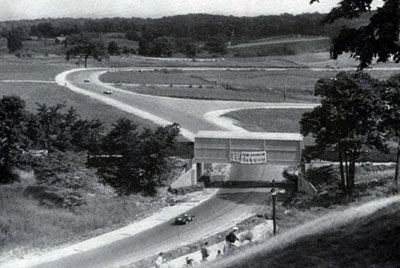
|
Same photo angle
taken one year later in 1956 with the bridge
up at turn 13. Cliff Tufte took care to
leave much of the landscape intact. You can
see the same trees survived construction of
the bridge despite their close proximity. |
|
|
The tee-intersection (above) beyond the bridge is the
intended exit
from the link for shorter course, which connects with turn 5
and the back straight called the Moraine Sweep. Also in
background of photo above is a narrow crossroad (between both
racecars), which leads to the main gate toward left, and
the main paddock off to right. Fifty years later, the Kohler
tunnel was built directly at that intersection and did
not alter the original
course configuration. The tunnel allowed the Turn 13
bridge to be removed, which had become
extremely hazardous to drivers hazardous and was
under-designed to meet loads of today's enormous
transporter rigs. |
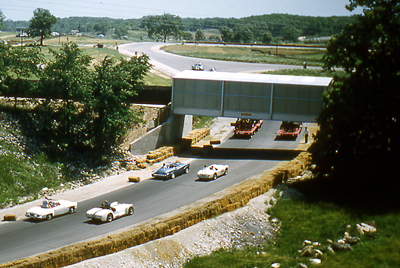
|
Sports cars enthusiasts taking a mid-day tour of
the track are passing under the bridge at
turn 13. The bridge allows an uninterrupted flow
of racecars in tow to and from the track while
the course it active, whether you arrive late or
leave early. June Sprints SCCA National -
June 20-24, 1956 |
|
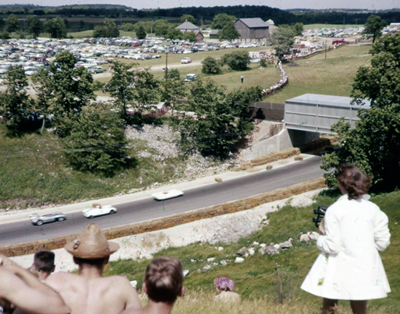
| Photo by Ron Nelson
Elkhart Lake's Racing Museum Looking northeast from Fireman's Hill at
turn 13 and Mitchell Bridge in mid-1950s. Spectators are
gathered on hillside viewing sports car race. You can
see the old farmhouse, barn and silo in background. (You
see... girls do like cars!) |
|
|
TRAGEDY AT BRIDGE ---- In
1970, Road America hosted its very first
Trans-Am SCCA race. The double-header featured
two Continental Championship races on Saturday.
The first was 20 laps (80 miles) for Formula B/C
cars, followed by Formula A cars in a 25 lap
(100 mile) race.
On Sunday, there were two Trans-Am sedan races.
The first was for Under-2-Litre class sedans and
the other for "Over-2-Litre" cars, which
typically included Mustang, Challenger, Camaro
and Firebird sport sedans. The race was won by
Mark Donohue #6 driving a Sunoco sponsored
Javelin for Roger Penske Racing. Second position
went to Swede Savage, and Sam Posey finished
third despite spinning twice.
On the previous day, early Saturday afternoon,
there was a bad wreck halfway through a 1-hour
long qualifying for Trans-Am, Over-2-Litre.
Apparently, there was an announcement suddenly
made over loudspeaker, "Ladies and gentlemen,
there has been a serious accident on the
course..." The announcer repeated several times,
"There's been an accident at Turn 13." The crash
involved one of racing's whole-hearted best,
Jerry Titus, SCCA championship driver and
automotive journalist.
Titus was approaching a slower car at a tricky
uphill left between turns 12 and 13, in the
stretch known as Thunder Valley. It is said; one
ordinarily doesn't have to use brakes there.
But, Titus apparently braked hard because his
wheels locked up while entering turn 13. Unable
to steer at that point, his Firebird skidded
headlong into the concrete abutment at Mitchell
Bridge. Located halfway through Turn 13, his car
hit at the outer corner of the bridge's concrete
stem and wing walls. The smoldering wreck caught
fire, but was immediately extinguished by
well-trained corner workers. Titus sustained
injuries to head and arm but was revived by the
track doctor who quickly arrived. Minutes
afterward, he was whisked away by ambulance crew
enroute to a Milwaukee hospital. After two weeks
of critical care and some progress, doctors had
expressed real hope of an eventual recovery, but
Titus passed away shortly after.
From the beginning and into the 1970s, sports
car road racing was a high-risk business for
many drivers as well as some spectators and
workers. The sport has seen great improvements
and has become very safety conscious, perhaps
fanatical to some. There is definitely an
attitude of safety first. Road racing circuits
are statically safer than driving on public
roads, which is where this whole thing began. |
|
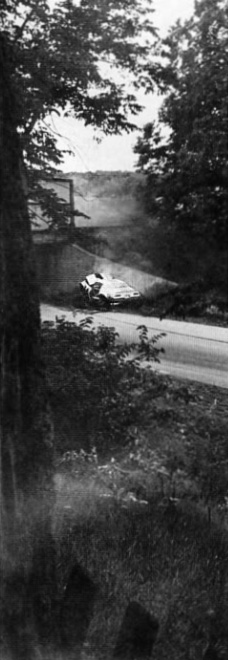
|
Looking southwest at Jerry Titus' 1970 Firebird after
impacting end wall of abutment during practice on
Saturday, July 18, 1970.
|
|
|
|
Comparison of photos taken from Fireman's Hill, which
offers one of the best vantage points on the track. You
can see the bend at turn 13 where it sweeps under the
bridge. In the middle is a link for shorter circuits.
Beyond is an access road for competitors arriving before
the track "goes hot". In the distance you can see turn
14 as it sweeps off to the right where cars then
accelerate up another hill on the front straight. |
|
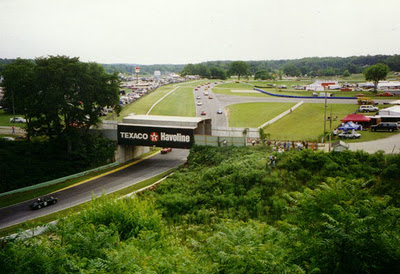
|
Looking east from Fireman's Hill at west
face of Mitchell Bridge during
Brian Redman Int'l Challenge vintage
race. -July 21, 1996 |
|
|
Forty-one years later, things are not much different. Some
of the same cars still run the course today, with the
growing popularity of vintage races. The tree
on right end of bridge has
since been removed with additional pedestrian fencing installed
along the bridge approaches. On the track below the
bridge, steel guardrails replaced hay bails to help
protect speeding drivers from the concrete abutment as
they approach the underpass. The Armco guardrail at the
bridge was later replaced by 3-foot high concrete
barrier walls. |
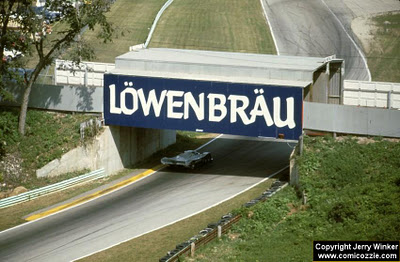
|
Photo by Jerry Winker View from Fireman's Hill (looking east)
of the west
elevation of Mitchell Bridge IMSA Camel GT race - August 22- 24, 1986
|
|
|
Al Holbert's #14 Löwenbräu sponsored Porsche 962 passes
under the Löwenbräu sponsored Mitchell Bridge during the
1986 IMSA Camel GT Löwenbräu Classic. Al Holbert and
co-driver Al Unser, Jr. started in 6th position and won
the 500-mile, 125-lap endurance race and $28,000. |
|
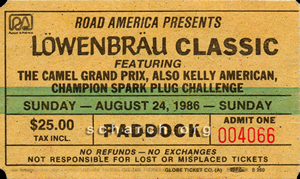 |
Lowen-behold!
I still have my old R/A gate
pass to the 1986 IMSA Camel GT Road America 500 on
August 22-24, 1986. Paddock pass was a few bucks
more and a must to get close and shoot a few
photos of world-class race cars and teams.
|
|
|
|
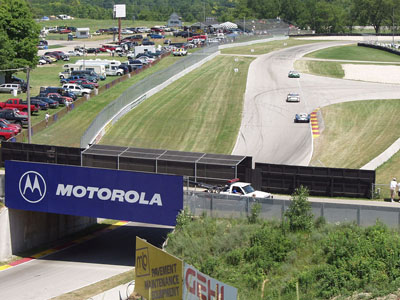
|
View from Fireman's Hill (looking east)
at west
elevation of bridge. A month later the right abutment
was hit hard by an Indy car driver and signaled
an end for the bridge located in the middle of Turn 13. Road America 500 - July 8,
2001/p> |
|
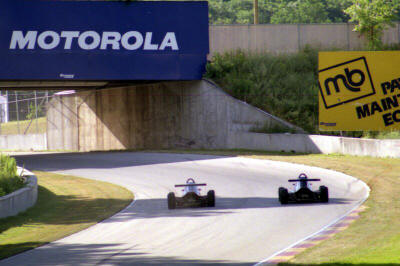
|
You can see the outline of the original concrete
stem wall, which was lengthened after widening
Mitchell Bridge. The Tire mark on the wall was
left by Memo Gidley's Indy car the previous
year's
2001 CART race. On the course
are Formula Mazda cars during the Star Mazda
Series and IMSA race on the weekend of July 6-7,
2002. (Photo by Mark Windecker) |
|
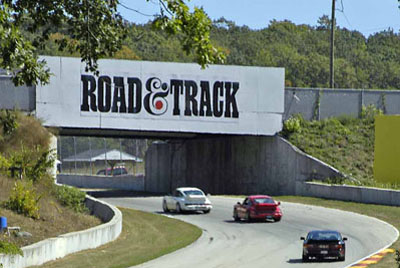
|
One of the last photos of the 51-year-old Bill
Mitchell Bridge at Turn 13. The right abutment
was cause for its removal. Porsche cars are
seen approaching west side from stretch of track called
"Thunder
Valley" between T 12 and T 13. (May 2006) |
|
|
The last
season for the 51-year-old Bill Mitchell Bridge was in 2006.
Its demise was its location, in the middle of an
extremely fast turn. The proximity of the concrete abutment on
the right side of the narrow underpass was not in
harmony with the directional forces of speeding cars.
Consequently, it is where Jerry Titus, Motorsports Hall
of Fame inductee, died when his Pontiac Trans-Am
Firebird experienced mechanical failure and impacted the
wall in 1970.
The bridge was
the only traffic route into the northern half of the paddock when
cars were on the course. A secondary surface road
nearest the paddock was preferable, but closed during
race sessions. This signaled the need for a major
improvement project for Road America. |
|
|
|
East Elevation of Mitchell Bridge
Series of views looking west at Turn 13
traffic crossover |
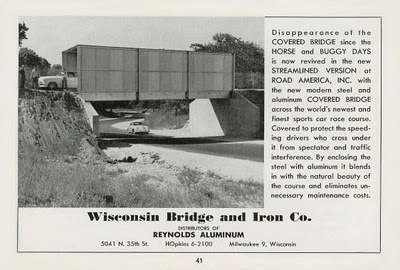 |
|
East elevation
of 'Mitchell Bridge' (looking west) shortly
after its completion in 1955. The abutment only has
the main stem bearing walls for the bridge deck. The
four splayed retaining wall extentions were not yet added.
Bridge guard rails and fencing
for both approaches were not yet in place.
At this point, one could say many items remained on the
punch list (to do) for Elkhart Lake's new Road America
racing circuit in Sheboygan County, Wisconsin. |
|
|
The Wisconsin Bridge and Iron Co. ran an ad in a 1956
Road America race program about the bridge they helped
construct at T 13.
They were also distributors of Reynolds Aluminum whose promotional reads, "Covered to protect the
speeding drivers who cross under it from spectator and
traffic interference." (It was more than just your
mother's i>Reynolds Wrap. It covered last night's
leftovers
and bridges too!) |
|
|
|
(RIGHT) The 1963 Road America June Sprints SCCA
National, with E-Production cars rounding Turn 5. - June
23, 1963
The view is looking northwest from Turn 5 across infield
at the eastern face of Bill Mitchell Bridge in
background. The bridge is located at Turn 13 where road
course runs under on north side of track. |
|
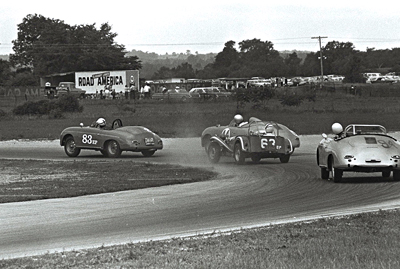 |
|
|
|
|
|
(RIGHT) Close-up view of Mitchell Bridge (looking west)
at Turn 13. E-Production cars are on the course during
the June Sprints SCCA National on June 23, 1963.
The S-shape bend in background is the stretch of track
aptly named "Thunder Valley". It extends from Turn 12
"Canada Corner" (beyond) to the bridge. |
|
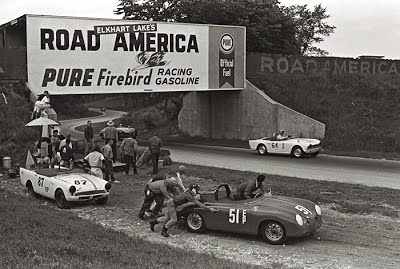 |
|
|
|
|
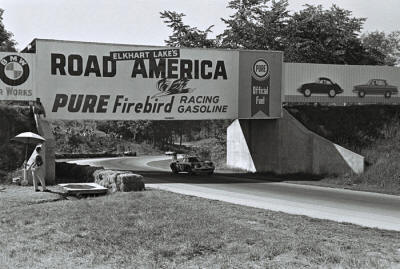
|
The eastern face of Mitchell Bridge during the Road
America 500, SCCA US Road Racing Championship on
September 13, 1964. Haybails still prevalent in days
before Armco Barrier. Passing under bridge is winning car no. 2
(over 2-liter) Ferrari 250 LM 6047 driven by Walt Hansgen and Augie Pabst.
|
|
|
|
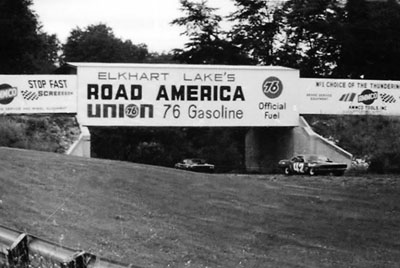
|
Looking west at the Turn 13 bridge abutments and
Trans-Am cars passing under.
The leading car is Swede Savage #42 in a 1970 Plymouth
Barracuda, after taking second position from Sam Posey #77 in
the 1970
Dodge Challenger trailing behind.
The Trans-Am SCCA sedan race was on Sunday,
July 19, 1970.
|
|
|
|
|
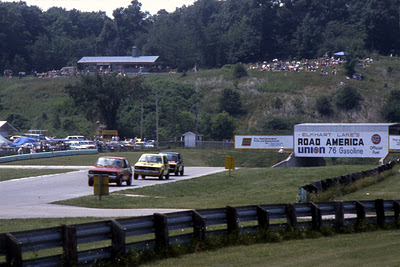
|
Looking west at Mitchell Bridge at foot of Fireman's
Hill with concession stand on top. It appears the bridge
roof was raised, probably to meet the needs of increased
heights of larger car transporters. Volkswagen Rabbits
setup for line into Turn 14, after passing
under the Turn 13 bridge. The Rabbit/Bilstein Cup Pro Racing Series
at R/A on July 20, 1980. (Photo by Mark Windecker) |
|
|
The Rabbit/Bilstein Cup was another pro racing series of
SCCA and was on the same weekend as their Trans-Am and Can-Am races
at Road America.
The VW Cup series was wildly popular and highly
competitive, as well as an affordable way for amateur
drivers to graduate into professional racing. A 1980
factory new Volkswagen Rabbit 2-door with added performance and safety
extras, to make race-ready, cost a little more than $9,000.00. |
|
|
|
|
|
|
removal of Bill Mitchell Bridge
Part of a major improvement plan and unforeseen
matter
|
|
Placing a bridge at the middle of a turn on a race track
is not a best practice of safety. The vehicle crossover was
built in 1955 at the mid-point of Turn 13, a very fast
bend taken at full power by many cars, especially today.
Originally, it may have seemed like the best location
for the only overpass on the north side of the track, given the
natural topography and surrounding landscape, and its
proximity to the paddock and pits. Also, earlier race
cars were not capable of zipping through turn 13 under
the bridge at 145 mph like the fastest cars could do a
few decades later.
It was the subject of an
investigation after numerous serious crashes, including
a 1970 crash that killed championship driver Jerry Titus and a
hard crash in 2001 by CART driver Memo Gidley, who was
lucky to have escaped with minor injuries after his Indy
car flipped over. The circuit became
unsuitable for motorcycle racing which began in the
1980s.
Kohler
Tunnel eventually replaced the Mitchell Bridge crossover.
A
new vehicle and pedestrian underpass was built further
downstream between turns 13 and 14.
CART/IndyCar driver Memo Gidley slammed into the
bridge's concrete abutment at 145-mph and wound up
trapped under his car. Gidley lost control when his
right front tire came in contact with the outer rumble
strip while approaching Turn 13 and the bridge. It took
safety workers a long time to extract Gidley. Amazingly,
he escaped with only two bruised knees.
See cockpit video of Memo Gidley's crash at same
abutment. (He was only bruised).
CART Elkhart Lake 2001 |
|
On December
5, 2006, Road America, Inc. broke ground on a $1.5
million construction project, which included the
addition of a new tunnel to the paddock. It allowed for
the removal
of the old Bill Mitchell bridge built at turn 13 in
1955. Unfortunately, the project also required removal
of the old barn and scoreboard to make way for the
tunnel's approach from the main gate.
The project was completed
in April 2007 as
part of the track’s long-range facility improvement
plan. The new tunnel is located approximately 100 yards
south of the farmhouse office, and provides
uninterrupted access to
the paddock between turns 13 and 14.
Designed to accommodate two lanes of vehicle traffic
and two pedestrian walkways, the tunnel is a 16-feet
tall, 36-feet wide and
168-feet long. McMahon and Associates of Neenah,
Wisconsin, designed the tunnel and served as general
contractor. The tunnel’s unique pre-cast concrete
structure enabled the tunnel to be located in a
desirable location near the farmhouse office and main
gate off of Highway 67.
The tunnel is the main entrance point into the
paddock, which will give team transporters a straight
shot into the paddock entrance from the main gate area. There was a grand opening celebration during
the AMA Suzuki Superbike Championship weekend, May
31-June 3, 2007, in conjunction with an official sponsor
entitlement. The ribbon was cut at the Kohler Tunnel Dedication
ceremony on Friday, June 1, 2007.
The goal of
the project was to enhance the racing experience for
spectators and competitors. In addition to better
paddock access, removal of the Bill Mitchell Bridge
created a new viewing area for spectators and provides
better track logistics for competitors. |
|
|
|
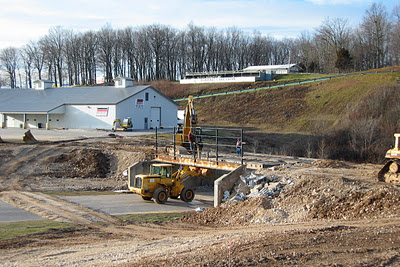
|
Looking southwest during dismantling
of at turn 13 bridge. - January 2, 2007 One of the tracks original concession
buildings sits on the hilltop, which later received a
viewing gallery addition. The Skip
Barber Racing School is behind the bridge in a white
metal building, at the foot
of Fireman's Hill. |
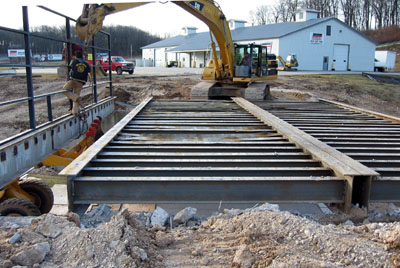
|
Looking south at stripped bridge deck showing exposed
steel girders and beams. Removal of deck beams for
pedestrian walkway is completed. The sidewall removal
is underway. - January 2, 2007 |
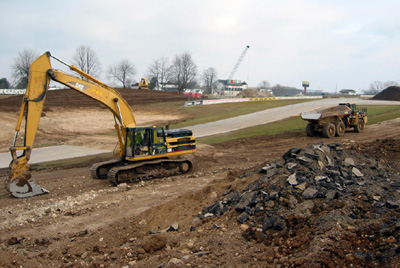
|
Looking northeast following bridge removal. The
dangerous abutment was located next to shovel of
backhoe. Asphalt from old approach is piled up in lower
right corner. The barn is in the background and crane,
before it, is working in trench of tunnel placing form
walls for concrete pour. - January 5, 2007 |
|
|
Bridge to nowhere
old approach road
|
-------> |
|
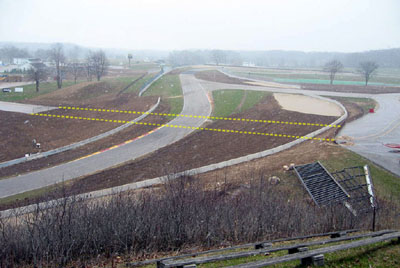
|
View
of Bill Mitchell Bend after bridge was
removed at yellow
dashed lines. A new section of
asphalt and grading can be seen in far
distance at Turn 14, is where tunnel is no
located. The old barn and silo are gone. Not
to mention, hay bails.
Contractor's photo April 9, 2007 |
|
|
<------- |
Remnants of
bridge guardrail
and deck steel
|
|
|
|
The Kohler Tunnel is located downstream further east, and crosses
(under) between turns 13 and 14 on the track's north side. It
allowed large transporters a straight driving line into the
paddock and allows pedestrians easier access. Bridge removal
also opened up new
vistas for spectators watching from Fireman's
Hill area. Turn 13 was renamed 'Mitchell Bend'
after the bridge named for GM auto designer was removed. |
|

